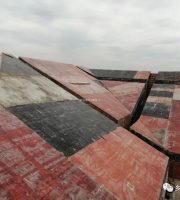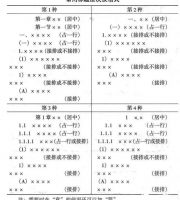2.
2.
The grounding wire of ordinary steel conduit adopts cross welding method; 2.
Construction process: construction preparation, grounding device installation, down lead equipotential connection 2.
Quality requirements: the material, specification, model and structural form of the supports and hangers must meet the requirements, and the fabrication and welding must be firm, the welds shall be full and beautiful, the installation and fixation shall be firm, and the spacing shall meet the requirements.
Production and installation of pipe supports and hangers 1 construction process: production of embedded positioning supports of iron parts to determine the horizontal elevation and spacing of supports and hangers 2.
Installation and fixation of supports and hangers 2 operating points: 1) embedded supports and hangers of iron parts: follow the structure construction, and the iron parts should be installed according to the coordinates, elevation Spacing positioning and embedding; Determine the horizontal elevation of supports and hangers on the embedded iron parts, and weld the fabricated supports and hangers on the embedded iron parts.
The welded junction shall be free of slag inclusion, undercut, crack, faulty welding, pore and other defects.
5.
The supporting claw lock nut is used at the incoming box of the ground wire of the tight set thin-walled steel conduit, and the set screw is screwed off at the pipe connection.
The outer wall of the welded pipe in the masonry is painted with anti-corrosion paint.
See the effect drawing: 1) the method of conduit entering the box note: JDG steel pipe is connected with the iron box, and the fixed jaw nut is used.
6) Pipeline grounding jumper note: 1.

Reserved pipe opening and pipe casing method 1 construction process: draw the opening drawing, review the opening positioning technology, and review the installation of formed casing at the opening 2 operation points: first, conduct comprehensive layout planning for all kinds of pipelines, determine the pipeline coordinates, elevation position and direction, draw the layout drawing, and construct according to the drawing after being confirmed by the owner, supervisor or designer.
The buried depth of concealed conduits shall not be less than 15mm from the surface of buildings and structures, and the clear distance of conduits used for fire-fighting facilities shall not be less than 30mm.
The jumper wire of galvanized steel pipe or flexible metal wire protection pipe shall be jumper connected with grounding wire clamp, and shall not be connected by fusion welding.
The embedded steel conduit shall be grounded.
Construction process: snap lines, locate and process elbows, concealed laying pipeline grounding jumper protection measures 2.
3) Form of supports and hangers: determine the structural form of supports and hangers according to the pipeline laying form of the design and layout drawing, and refer to the requirements specified in the atlas of indoor pipeline supports and hangers, and process and manufacture on site or in factory.
3.
2) On site expansion bolt fixed supports and hangers: the strength and tension of the selected expansion bolts must ensure that the provisions of the pipeline are firm, safe and reliable; The spacing, elevation and coordinates of supports and hangers shall be determined according to the planning layout.

When plastic pipes are laid horizontally in the large formwork wall, the spacing between fixed points shall not be greater than 0.5m.
The wall entry pipe of directly buried cable must be waterproof, and its buried depth is not less than 700mm away from the outdoor surface, and there is a waterproof slope (5p0p~10p0p).
When the length of straight section exceeds 15m or there are more than 3 right angle bends, junction box should be added.

4.
2.
4.
See the effect drawing 1) plate reinforcement and pile foundation grounding device practice 2) using the main reinforcement of the vertical structure as the lightning protection downlead routine practice (according to the design or local regulations) Note: using the main reinforcement of the building as the concealed downlead: when the reinforcement diameter is 16mm and above, two reinforcements (binding or welding) should be used as a group of downleads; when the reinforcement diameter is 10mm and above, four reinforcements should be used as a group of downleads..
Key construction points: conduct surveying, setting out and positioning according to the construction drawing, coordinate and elevation, direction, determine the location of junction box, and it meets the design requirements after review.
Specification table of jumper wire 7) protective practice of plastic pipe out of the ground note: when laying plastic pipe, bending should be reduced.
After inserting and positioning, use a set wrench to tighten the set screw continuously until the “neck” is broken to make it a whole, and there is no need to make a jumper wire.
The pipes laid in reinforced concrete walls and floors shall be bound and fixed close to the inner side of the reinforcement, and the spacing between fixed points shall not be greater than 1m when laid in a straight line.

Quality requirements: steel pipes below sc25 shall be bent with matching pipe bender, and pipes above sc32 can be bent with pipe bender or hot simmer method.
2) Note: 1.

Quality requirements: ensure that the position and size of the reserved hole are correct.

3.
3.



1.
Quality requirements: all casings should be flush with the wall, and the ones out of the floor should be 20mm higher than the floor finish, (toilets and pipe wells should be 50mm) 4.
Galvanized steel pipe grounding wire adopts the method of grounding wire clip bridging; 3.

4.
See the effect drawing: 2.
See the effect drawing: 4.
For special supports and hangers or supports and hangers other than those in the atlas, they should be calculated and rechecked, and made of qualified section steel to ensure that the supports and hangers are firm, safe and reliable.
3.
The conduit is straight into the box and fixed with a special lock nut.
The bending flatness of the pipeline shall not be greater than 10% of the outer diameter of the pipe, and there shall be no wrinkles, pits, cracks and other phenomena at the bending.
welded steel pipe practice 1.
See the effect drawing 3.


Embedding of waterproof casing 1 construction process: making casing positioning and fixing technology, rechecking installation and forming 2 key points of operation: according to the design, flexible waterproof casing or rigid waterproof casing shall be used, and the material, specification and size of the casing shall be manufactured or purchased on the market according to the requirements of the standard atlas of waterproof casing; Bind or weld on the structural reinforcement according to the coordinate size of the layout confirmed by the planning.

4) Note: 1.
4.
3.
5) Note: 1.
Quality requirements: according to the size and location requirements of the design drawing, the grounding device will weld and connect the two main structural reinforcements in the bottom plate and weld with relevant reinforcements (such as pile foundation reinforcement).
After the fabrication is completed, the rust shall be removed and 2 layers of antirust paint shall be applied.
3) Pipeline connection note: butt fusion welding connection of metal conduits is strictly prohibited; Galvanized and steel conduits with wall thickness less than or equal to 2mm shall not be connected by sleeve fusion welding.
Put on the belt wire in time, and effectively block the pipe orifice, box orifice and box orifice.
It is recommended to use common supports for centrally arranged pipelines, and strengthen design optimization and construction planning.
Lightning protection and grounding 1.
Construction points: the material used for lightning protection and grounding must be hot-dip galvanized products.


